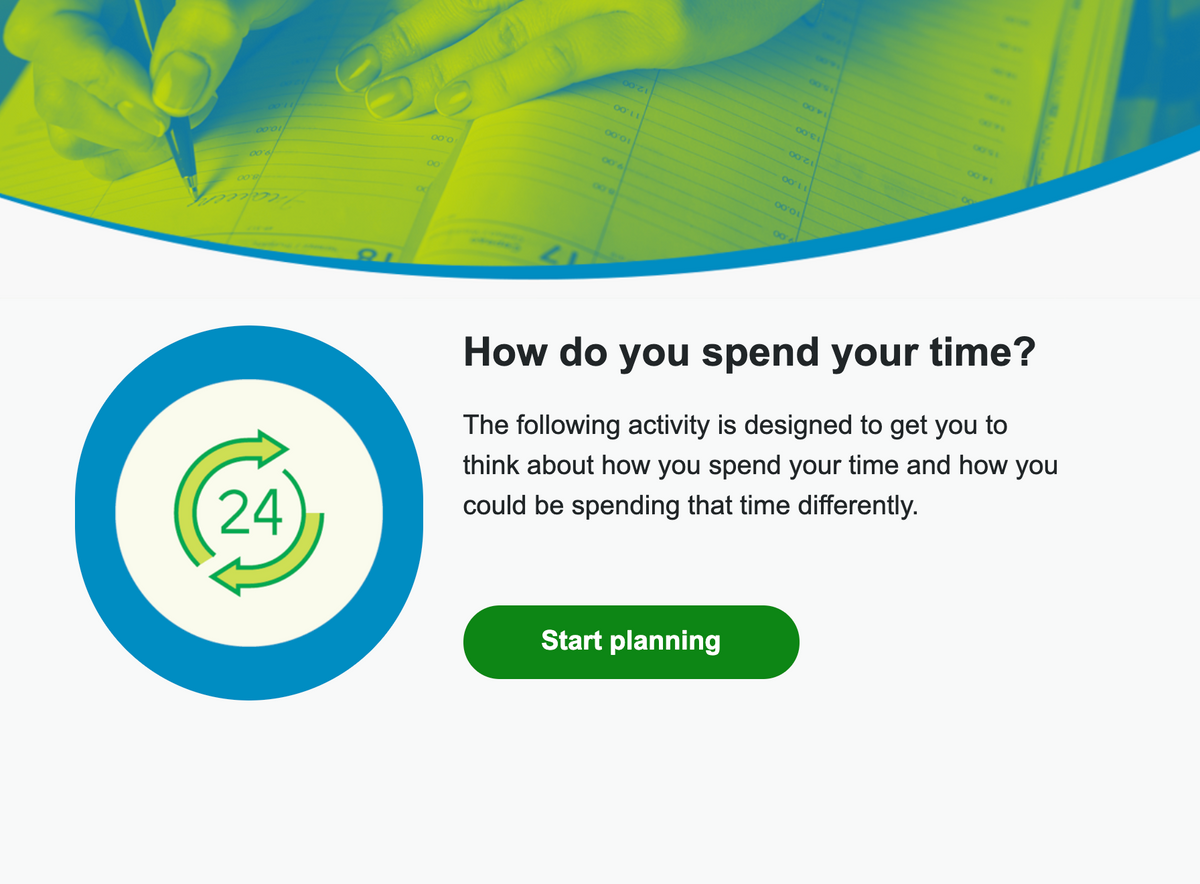Introduction
“ I don’t have time…”

How often have you noticed yourself saying those words, especially when your workload gets heavy?
Life can get complicated. Sometimes the demands of a busy schedule seem overwhelming. Everyone seems to want a piece of your time. Many people have trouble dealing with the stress of time management. Some even develop serious health problems.
Before we get started with this learning activity, take a few moments to think about all of the demands on your time. It’s not easy to find time for schoolwork, family, friends, perhaps a job, as well as your other daily activities. Are you a good time manager? Are you able to juggle all of your responsibilities and still have time to enjoy yourself? This learning activity will focus on ways that you can improve your time management skills in order to become a more effective learner.
Transferable skills
One of the skills we are practicing in this learning activity is “Self-Directed Learning.” This learning activity can help you to develop the ability to set realistic goals, stay motivated, and work independently. You will also practice good and healthy time-management skills by creating a calendar to help keep you accountable.
Time flies

Although many of us complain that we have too much to do and too little time, few of us examine our use of time. You may have noticed yourself saying “I don’t have time to do that”, but if you reflect on the ways in which you spend your time, you may come to a different conclusion. Perhaps the problem is not that you don’t have enough time, but that you need to use your time in a different way.
Take Alan, for example.
Alan is a 17-year-old student. In addition to schoolwork, Alan works 10 hours a week, plays on a soccer team, is a member of the school band, and likes to play baseball with friends. Lately, Alan has been spending more time at night on the computer and on the phone chatting with friends. Alan has done poorly on two recent tests because of “lack of study time”. Alan’s parents are putting pressure on him and emphasizing the importance of improving marks in school.
There is no question that Alan has a very busy life. However, does this mean that Alan cannot do well in school while taking part in all other activities? With some careful scheduling and an evaluation of their use of time, Alan can probably do all the activities and still have time to do well in school.
Notebook
In your notebook, please respond independently to the following question prompts.
Question: Describe some suggestions you could offer Alan that would give more time to do schoolwork, and still give time to take part in all other activities?
Student Ancilla’s answer:
Alan needs to put the phone away and limit computer time. Also, Alan needs to ensure there is enough study time while still getting proper sleep.
Keep track of how you spend your time

Before you can create a time management plan for yourself, you need to examine how you spend your time. Have you ever stopped to think about everything you do, 24 hours a day, seven days a week? Many people don’t sit down and try to account for how they use their time.
In order to get a better idea of how you spend your time, complete the chart on the following page – the results might surprise you.
Press Enter here for an accessible version of Use of time inventory activity. (Opens in new window)
Nearly everyone is tempted by distractions when they need to complete their schoolwork or study for a test. The key is not to let these distractions get you off track. Let’s continue this learning activity exploring six strategies to improve your time management skills.
Six strategies to improve your use of time
Time management is a skill that must be learned and practiced. The following list will provide you with some strategies to help you develop your own time management plan.

Learning to prioritize
One simple way to prioritize is to assign A, B, or C to each task:
| A | Very important — I must get this done |
|---|---|
| B | Important — I should get this done (things will work out better if I do) |
| C | Not urgent — if I can get everything else done, I will work on this |
Activity
Go through a list of things that you have to do right now and assign priorities. Then continue working on the other steps mentioned above and schedule them. If you have too many A priorities, review them and try to identify if any could become B or C priorities.
Notebook
You can use your notebook to answer the following question.
Can you give an example from your own life of three things that you needed to do today or this week, in the order of A, B, C priorities?
Student Alana’s answer:
Today (Monday), I need to get a new outfit for a family event this weekend, I need to write a paragraph for English class, and I need to make dinner for my mom tonight.
A: Write My English Paper: Due tomorrow
B: Make Dinner for Mom
C: Go shopping another day this week for the outfit
Helping Raj with time management
Read the following scenario.
Raj is feeling stressed out because a major assignment is due in four days. Raj’s football team has made the play-offs, which means the coach will need the players go to extra practices. Also, Raj’s parent says they have a family dinner tonight and must attend.

Join the discussion
Suggestions for Raj
Question: Using what you’ve learned, what are two suggestions you could offer Raj to help with completing the assignment on time?
Instructions:
- Post your response to the question.
- Read 3-4 posts from your fellow classmates.
- Choose 1 post to complete a 3C’s and a Q.
3C’s and a Q:
- Compliment (I like the …; I like how…)
- Comment (I agree/disagree…; I think …)
- Connect (I have also seen/heard/read/learned…)
- Question (I wonder why/who/what/when/where/how …)
First suggestion
Student Antonio’s answer:
Create a study schedule and make a plan for studying that also accounts for time playing football and spending time with family.
Second suggestion
Student Annie’s answer:
Raj needs to understand and realize limits. Raj should speak with the parent about other commitments and potentially tell the football coach that schoolwork must be finished before attending extra practices.
Learning to prioritize
The strategies you have learned so far in this learning activity are just some of the ways to implement some new ways to improve time management. Let’s continue this learning activity by checking out how you use your time when it comes to your school study habits.
How do you use your study time?

Personal inventory of your study habits
By now, you have probably figured out that it is important to reflect on your current learning habits if you want to improve them. In other words, you can’t change until you examine what you are doing.
Notebook
You can use your notebook to answer the next series of question prompts.
- My preferred learning style is:
Student Maki’s answer:
My preferred learning style is visual learning.
- My preferred time of day for doing homework or studying is:
Student Maki’s answer:
I like studying in the evening, after dinner.
- When I am doing homework or studying, I am distracted by:
Student Maki’s answer:
My cellphone and my friends messaging me.
- My ideal homework/study environment includes:
Student Maki’s answer:
Sitting at my desk in my bedroom, listening to music on my headphones.
- My homework/study time would be used more effectively if I:
Student Maki’s answer:
Put my phone away or on silent and sat at my desk instead of lying on my bed like I usually end up doing.
- What conclusions about your use of homework/study time can you draw from your answers to these questions?
Student Maki’s answer:
I need to improve my study habits by studying at a desk and working to minimize the time I spend on my cellphone. If I do these things I will be using my study time most effectively.
Making the most of your homework/study time
Making the most of your study time can be tricky. Let’s now consider how you can improve your own study habits. First, read this article independently on how to “study smart (Opens in new window).”
Now that you’ve read the article, check your understanding by working through the following questions.
Study tips
Hopefully, that article cleared up a few myths about studying that you may have had. Let’s explore some more study tips that you may find helpful.
Now that you’ve reviewed these study tips, identify which tip is being used in each of the following scenarios.
Notebook
You can use your notebook to answer the next series of questions.
Your time management skills
Many of those study tips focused on being able to manage your time well. Think about yourself and your own time management skills. Then, answer the following set of questions.
- Identify two of your strengths related to time management. Give two examples of ways in which you have demonstrated these strengths.
Student Nafisa’s answer:
I am very good at reviewing my class material every night and taking lots of time to prepare for assignments.
- Identify your two biggest time management-related challenges. Give two examples of ways in which these challenges have affected your learning in school.
Student Hodan’s answer:
I need to work on taking more breaks and knowing myself so that I’m not setting unrealistic expectations for what I can get done in a single day.
- Describe two strategies you can use to improve your time management skills.
Student Daniel’s answer:
Since I always end up doing assignments at the last minute because I haven’t planned out my week well, I could work on creating a study schedule. I also need to set expectations that are realistic to ensure that I can get everything done as planned.
Hopefully, these tips and the reflection on your own study habits have inspired you to make some changes in the way you approach your schoolwork. Let’s put everything you have learned in this learning activity into practice by creating a study plan for this course.
Making a time management plan for GLS1O

What better way to demonstrate your ability to manage time and to use the homework/study skills that you’ve learned in this learning activity then by planning out how you will successfully complete this course?
To start, reflect back on your course progress so far in Unit 1.
Notebook
You can use your notebook to answer the next series of prompts.
- Estimate how many hours you plan on working on the course each week.
- On average, how long have you spent working through each learning activity so far? Using that information, estimate the amount of time you will need to read and study the material in each learning activity.
- Describe how you will make time in your daily schedule to complete the work in each learning activity.
Assessment opportunity
Creating a plan
Create a calendar for completing the rest of this course. This is an assessment for learning. It is meant to help you and your teacher determine where you are in your learning, where you need to go, and how best to get there. Although feedback will be provided, no marks will be assigned.
The type/format of calendar is up to your personal preference. You can use a calendar template on your computer, an app, printed agenda, etc.
In your calendar, record the following:
- Due dates for the graded projects for each unit (GLS1O).
- Due dates for graded projects in your other courses.
- Important events and obligations outside of school (i.e. family events, sports/team events and practices, club meetings, part-time work schedule, volunteer shifts, etc.).
- You may wish to try using a colour-code system (assign a different colour to each course) to further visualize your month(s) at a glance. Recall, this can be very helpful for visual learners!
- Make a separate schedule for next week. Be sure to include specific times.
What does a typical day look like for you? Can you restructure your day to ensure you have enough time for all of your commitments, schoolwork, and doing things you enjoy with family and friends?
Show your plan to a mentor like a teacher, parent, or family friend, etc. Explain that you have these goals in place, how you intend to achieve them, and ask them to keep you accountable.
To submit your calendar, follow the instructions provided by your teacher.
It is also important that you keep a copy for yourself that you can easily access and refer to throughout the course.
When you are ready, submit your assessment by pressing the “Submit Your Work” button and follow the submission directions.
Conclusion

Time does not have to be your enemy. Through careful planning and effective use of your time, you can meet all of your obligations and still have time to do the things you want to do. The people who are most successful in school (and in life) have typically figured this out. Recall that the number of hours in a day can’t change, but you can change how you use those hours!



